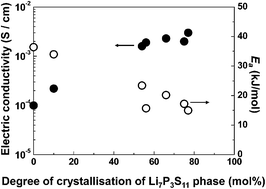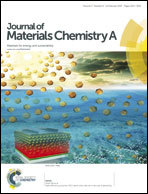Analysis of the structure and degree of crystallisation of 70Li2S–30P2S5 glass ceramic†
Abstract
Heat treatment of Li2S–P2S5 glasses to transform the glass to a glass ceramic enhances the ionic conductivity by precipitating a Li7P3S11 metastable crystalline phase with high ionic conductivity. Although the precipitated phase is identical, the conductivity achieved varies depending on the heat treatment conditions. Solid-state 31P MAS NMR spectroscopy to investigate the structure of the glass ceramic in this study revealed a strong correlation between the ionic conductivity and the degree of crystallisation, in which the conductivity of the glass ceramic increased with increasing proportion of metastable Li7P3S11 phase.


 Please wait while we load your content...
Please wait while we load your content...